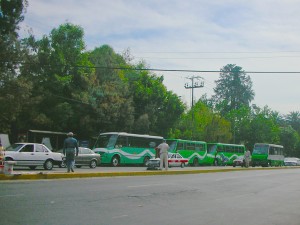A brief conference report on Megalópolis Sonoras: Sonidos en peligro de extinción (Sound Megalopolis: Cultural Identity and Sounds in danger of extinction) organized by the World Forum for Acoustic Ecology (WFAE) and the recently founded Mexican Forum for Acoustic Ecology. The conference took place March 23–27 at the gorgeous Fonoteca Nacional in the beautiful Coyoacán neighborhood of Mexico City.
On Monday morning the national media were massed for the conference’s inaugural ceremony.

Following the inaugural ceremony, Hildegard Westerkamp led a large group of us on a sound walk through the huge park nearby, the Viveros de Coyoacán.
At the conference Derrick de Kerckhove gave the keynote on Monday morning. On Tuesday Barry Blesser gave his keynote, and R. Murray Schafer gave his keynote this morning. Sabine Breitsameter will be the keynote speaker this Thursday morning.
The numerous talks and diverse perspectives of the speakers are too numerous for me to describe in a few words and still hope to convey a sense of the breath and depth of the ideas and information. I’ll mention a few here.
Andrea Polli spoke on her recent sonification work in Antarctica. Luz Maria Sanchez spoke on sound maps, Carla Teixeira spoke of fences in Australia (reference to Hollis Taylor’s and Jon Rose’s “Great Fences of Australia Project”, Constantinos Stratoudakis discussed his research in reconstructing soundscapes in virtual space based on the data mapping of actual soundscapes. Andreas Mniestris spoke on similar effort in Greece, on the island of Corfu. Andreas also informed us of the surprisingly large amount of activity in the field of acoustic ecology (61 members in their local WFAE chapter, the Hellenic Society for Acoustic Ecology).
As a new board member of the American Society for Acoustic Ecology I have been meeting with fellow board members to make plans for the future of the WFAE. This is a rare opportunity to meet face to face with the individuals from the international affiliates of the WFAE.
Currently, there are nine affiliates. WFAE Chair Nigel Frayne published a report on the history and outlook of the WFAE in the Fall/Winter 2007 of Soundscape: The Journal of Acoustic Ecology.
An interesting historical fact: Lidia Camacho, Director General of the Fonoteca Nacional, informed us that its location is in the former home of the famous Mexican poet Octavio Paz (1914-1998). Coyoacán is also where Leon Trotsky, a friend of Frida Kahlo and Diego Rivera, lived in exile with his family and was murdered, in 1940.
Listen to an audio clip from the street sounds of Mexico City:
